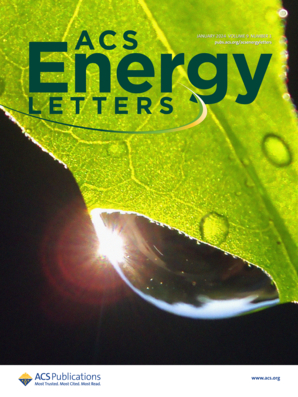Anisotropic Cation Migration Drives the Formation and Stability of Lateral 3D/2D Perovskite Heterostructures
IF 19.3
1区 材料科学
Q1 CHEMISTRY, PHYSICAL
引用次数: 0
Abstract
Lateral 3D/2D perovskite heterostructures, which combine the high efficiency of 3D phases with the stability of 2D structures, have shown great potential in energy and optoelectronic applications. However, the ion migration dynamics driving their formation and stability remain unclear. Here, we use fluorescence microscopy to investigate the anisotropic migration of A-site cation methylammonium (MA+) and formamidinium (FA+) in phenylethylammonium lead bromide (PEA2PbBr4) nanoplatelets. We demonstrate that edge-initiated, preferential in-plane migration of these cations leads to the lateral growth of 3D domains at the edge of nanoplates, forming lateral 3D/2D perovskite heterostructures. FA+ migrates more slowly than MA+ due to the relatively large steric hindrance, suppressing the formation of transient quasi-2D phases and enhancing the phase purity and structural stability of the heterostructures. These results highlight the importance of cation selection and interface design in optimizing ion migration dynamics, offering key insights into improving the stability and performance of 3D/2D perovskite-based optoelectronic devices.

各向异性阳离子迁移驱动横向三维/二维钙钛矿异质结构的形成和稳定性
横向三维/二维钙钛矿异质结构结合了三维相的高效率和二维结构的稳定性,在能源和光电子领域显示出巨大的应用潜力。然而,驱动它们形成和稳定性的离子迁移动力学仍不清楚。在这里,我们使用荧光显微镜研究了a位阳离子甲基铵(MA+)和甲脒(FA+)在苯乙基溴化铅(PEA2PbBr4)纳米血小板中的各向异性迁移。我们证明,这些阳离子的边缘引发,优先在平面内迁移导致纳米板边缘的3D畴的横向生长,形成横向3D/2D钙钛矿异质结构。由于相对较大的位阻,FA+的迁移速度比MA+慢,抑制了瞬态准二维相的形成,提高了异质结构的相纯度和结构稳定性。这些结果突出了阳离子选择和界面设计在优化迁移动力学中的重要性,为提高3D/2D钙钛矿基光电器件的稳定性和性能提供了关键见解。
本文章由计算机程序翻译,如有差异,请以英文原文为准。
求助全文
约1分钟内获得全文
求助全文
来源期刊

ACS Energy Letters
Energy-Renewable Energy, Sustainability and the Environment
CiteScore
31.20
自引率
5.00%
发文量
469
审稿时长
1 months
期刊介绍:
ACS Energy Letters is a monthly journal that publishes papers reporting new scientific advances in energy research. The journal focuses on topics that are of interest to scientists working in the fundamental and applied sciences. Rapid publication is a central criterion for acceptance, and the journal is known for its quick publication times, with an average of 4-6 weeks from submission to web publication in As Soon As Publishable format.
ACS Energy Letters is ranked as the number one journal in the Web of Science Electrochemistry category. It also ranks within the top 10 journals for Physical Chemistry, Energy & Fuels, and Nanoscience & Nanotechnology.
The journal offers several types of articles, including Letters, Energy Express, Perspectives, Reviews, Editorials, Viewpoints and Energy Focus. Additionally, authors have the option to submit videos that summarize or support the information presented in a Perspective or Review article, which can be highlighted on the journal's website. ACS Energy Letters is abstracted and indexed in Chemical Abstracts Service/SciFinder, EBSCO-summon, PubMed, Web of Science, Scopus and Portico.
 求助内容:
求助内容: 应助结果提醒方式:
应助结果提醒方式:


